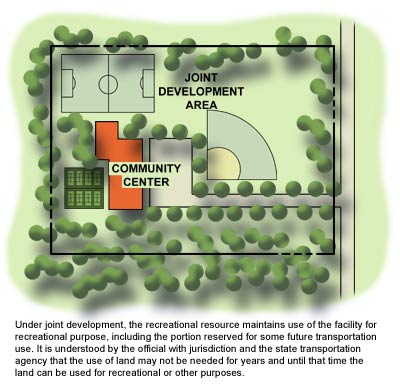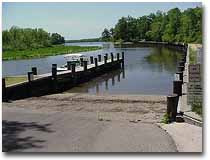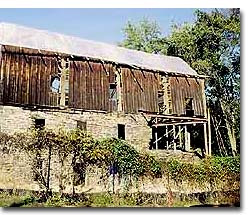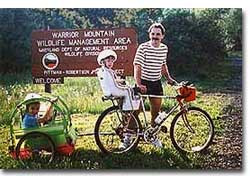Use
OTHER CONSIDERATIONS
While Section 4(f) use generally refers to the four main instances addressed in Types of Use, there is a wide range of situations that may also constitute a use of a Section 4(f) property. We refer to these unique situations broadly as "Other Considerations". Some of these situations may be characterized as use, per se, while others may not. This section of the tutorial introduces you to the ones you're most likely to encounter:
| Note: The list of Other Considerations described in this section of the tutorial is not exhaustive, so be aware that you could come across one is not discussed here. All scenarios should be examined on a case-by-case basis. The final decision rests with the FHWA on all matters regarding applicability of Section 4(f). | |
Joint Development
Joint development involves planning for a park, recreational area, or refuge and a transportation facility that occurs at the same time wherein a portion of land is reserved or set aside from the Section 4(f) property for future transportation purposes. Because it is assumed during the planning process that the reserved land may be used at some point in the future, Section 4(f) does not apply to it.
Documented evidence must be provided in order to demonstrate that the area in question was reserved for transportation purposes before or at the same time that the adjacent portions were designated as a park, recreational area or refuge property. The absence of such documentation and coordination may result in application of Section 4(f) to the area that had been reserved for transportation purposes.
If the State DOT elects to allow park, recreation, or refuge activities to occur during the interim between the reservation of the land and the advancement of the transportation project, it is advisable to document the decision in a formal permit. The permit should include specific terms of limitation (see Temporary Occupancy of Highway Right-of-Way discussion below).
 |
|
Alternate View |
Air Rights/Tunneling
Air rights, under Section 4(f), typically refer to areas in the vicinity of an elevated structure such as a bridge or ramp in the vicinity of a Section 4(f) property. A Section 4(f) use does not occur unless the structure’s piers, abutments, or other appurtenances are physically located on the Section 4(f) property. When the structure completely spans the Section 4(f) property, it would not typically result in a Section 4(f) use; however, its proximity (including vertical clearance) must be evaluated to determine if there is a substantial impairment to the property resulting in a constructive use.
Tunneling under a Section 4(f) property will result in a Section 4(f) use only if one or more of the following conditions are met:
- Archeological sites that warrant preservation in place are adversely affected;
- There is permanent harm to the purposes for which the park, recreation area, or refuge was established;
- There is substantial impairment to the integrity of a historic site; or,
- The exception for temporary occupancy is not met.
Temporary Occupancy of Highway Right-of-Way
Temporary occupancy of highway ROW involves land formally reserved for a future highway ROW
that temporarily functions for park, recreational, or refuge purposes. Sometimes park, recreational,
or refuge facilities will occur, with or without authorization, within a ROW.
If the State DOT considers allowing an authorized use of the ROW, it is advisable to include
in any limited occupancy permit reversionary clauses that make it clear any park, recreational,
or refuge activities are interim and that no long-term right or public expectation to occupy
the transportation ROW has been created. Documentation should make it clear that any non-transportation
activity on the reserved ROW will cease once the land is required for completion of the transportation
project.
Late Discovery
Late discovery refers to the discovery of a Section 4(f) resource after completion of the National Environmental Policy Act The National Environmental Policy Act of 1969 (NEPA) is considered to be the basic "National Charter" for protection of the environment. NEPA requires Federal agencies to use an interdisciplinary approach in planning and decisionmaking for actions that impact the environment. (NEPA) process (i.e. after Record of Decision/Finding of No Significant Impact/Categorical Exclusion completion). Reasons why this may occur include a lack of detailed ROW information during environmental studies, changes to the selected alternative during final design, or new information or discovery during construction.
When a late discovery occurs, timely coordination between the State DOT or project sponsor and FHWA is required to determine if an individual, programmatic, or amended Section 4(f) evaluation is required. The findings of the coordination and documentation will be considered during NEPA reevaluation and ultimately may result in changes to the project design or construction plans. In a worst case scenario, a late discovery may require modifications to the selected alternative or selection of a new alternative.
Archeological sites that are discovered during construction must be evaluated to determine if they are important chiefly for what can be learned from data recovery and they have minimal value for preservation in place (Section 4(f) does not apply when this determination is made).
Note: Reasonable precautions should be taken to avoid or minimize the potential for a late discovery situation, since it will likely cause considerable disruption in the project schedule.
Late Designation
Late Designation refers to the change of a property's Section 4(f) status late in the development of a proposed project. Except for archeological sites, which should be addressed according to the provisions discussed under late discovery above, A place (or group of physical sites) in which physical remains of past human activity that are at least 50 years old are preserved, and which has been, or may be, investigated using the discipline of archaeology and represents a part of the archaeological record. the State DOT may proceed without consideration under Section 4(f), after consultation with FHWA, if the newly designated Section 4(f) property was acquired for transportation purposes prior to the change in designation and if an adequate attempt was made to identify Section 4(f) properties.
Note that the effort to identify potential Section 4(f) properties requires thorough documentation of communication with the likely Federal, State and local officials with jurisdiction. The absence of such documentation and coordination may result in a Section 4(f) use. Every precaution should be taken to avoid this type of use, since it may cause considerable disruption to a project schedule.
Project Mitigation Activities within Section 4(f) Properties
In some cases, mitigation activities for impacts caused by projects are proposed within the boundaries of a Section 4(f) property. An example is wetland mitigation in urban areas where there is limited open space. Enhancement or rehabilitation of an existing wetland might be proposed in a publicly owned park or refuge for wetland impacts caused elsewhere by a project. If the mitigation on Section 4(f) property is solely for the purpose of preserving or enhancing that property, then a Section 4(f) use does not occur. The official(s) with jurisdiction over the property must concur in writing with this assessment. FHWA’s decision should be documented in the project file.
Boat Access Ramps
 Section 147 of the Federal Aid Highway Act of 1976 provides for the construction of access
ramps to public boat launching areas adjacent to bridges being built or reconstructed on Federal
highways. These ramps may be on public lands adjacent to the highway ROW or within the highway
ROW. The FHWA and the Department of the Interior (DOI) have agreed that it would be contrary
to this provision to search for feasible and prudent alternatives that would avoid construction
of such ramps on public lands when the officials with jurisdiction have been consulted and
are in agreement with the placement. Consequently, Section 4(f) does not apply to construction
of boat access ramps in such instances. Section 4(f) would apply to bridge construction that
requires acquisition of land from a Section 4(f) property in order to complete the bridge.
In short, transportation projects involving the construction of boat access ramps may involve
Section 4(f) use; however, the construction of boat access ramps does not, in itself, generally
constitute use.
Section 147 of the Federal Aid Highway Act of 1976 provides for the construction of access
ramps to public boat launching areas adjacent to bridges being built or reconstructed on Federal
highways. These ramps may be on public lands adjacent to the highway ROW or within the highway
ROW. The FHWA and the Department of the Interior (DOI) have agreed that it would be contrary
to this provision to search for feasible and prudent alternatives that would avoid construction
of such ramps on public lands when the officials with jurisdiction have been consulted and
are in agreement with the placement. Consequently, Section 4(f) does not apply to construction
of boat access ramps in such instances. Section 4(f) would apply to bridge construction that
requires acquisition of land from a Section 4(f) property in order to complete the bridge.
In short, transportation projects involving the construction of boat access ramps may involve
Section 4(f) use; however, the construction of boat access ramps does not, in itself, generally
constitute use.

Trails
Trails which are part of the local transportation system and that function primarily for transportation purposes are not subject to Section 4(f). Trails that occupy part of a transportation facility ROW but are not limited to a specific location within that ROW are not subject to Section 4(f) so long as the continuity of the trail is maintained. Trail-related projects funded under the Recreational Trails Program are exempt from Section 4(f).
Transportation Enhancement Projects and Mitigation Activities
Many of the properties that are subject to transportation enhancement projects or mitigation activities are protected by Section 4(f).

If a transportation enhancement activity, as provided for in several FHWA programs, or mitigation
involving construction on Section 4(f) property is solely for the purpose of preserving or
enhancing that property, then a Section 4(f) use does not occur. The
official(s) with jurisdiction The legal representative of
the agency owning or administering the resource, unless the agency has delegated or relinquished
this authority via formal agreement. For historic properties, the Official with Jurisdiction
is the State or Tribal Historic Preservation Officer. over the property
must concur in writing with this assessment. For a Section 4(f) use to occur in conjunction
with these activities, there would have to be a conversion of land from an existing Section
4(f) property to a transportation use. In other words, the State DOT must acquire land from
a Section 4(f) property and convert its function from park, recreation, refuge, or historic
purposes to a transportation purpose.
